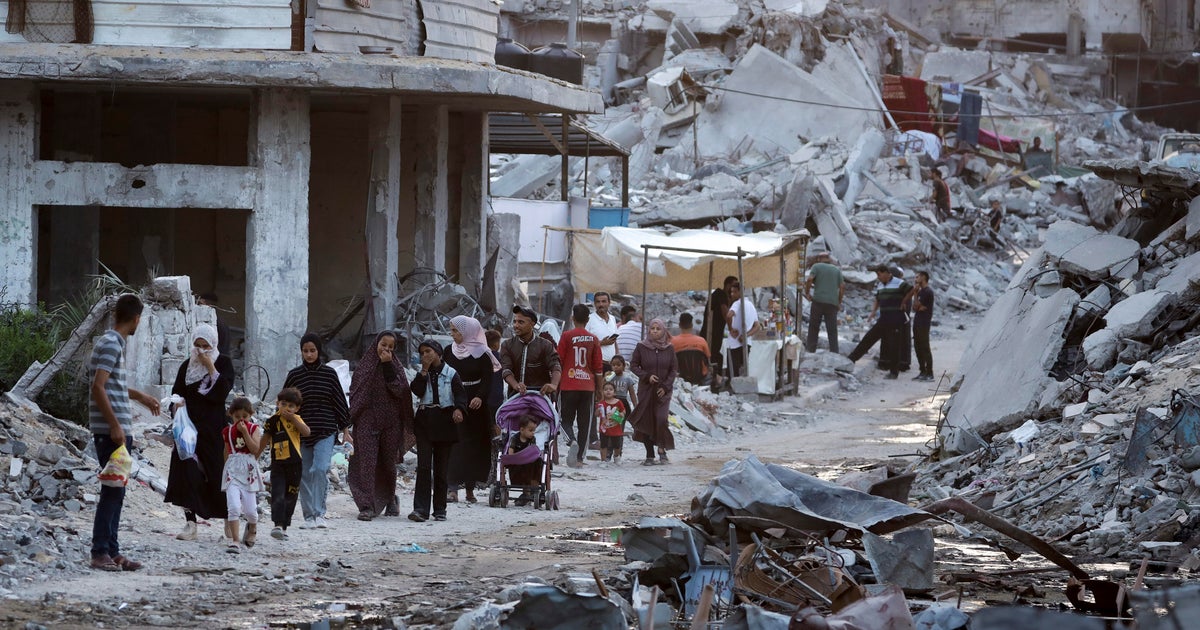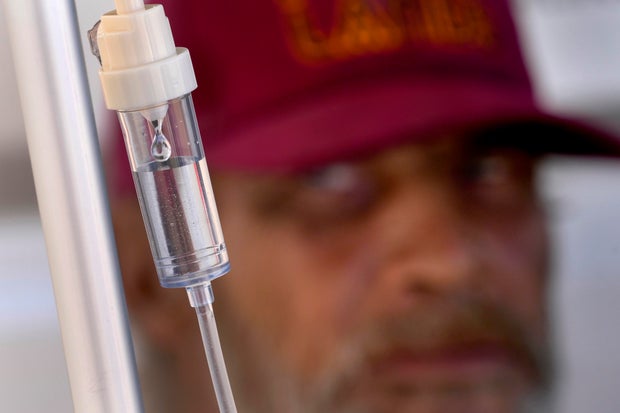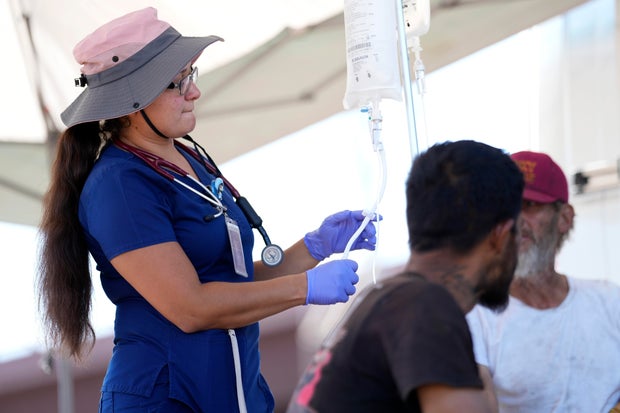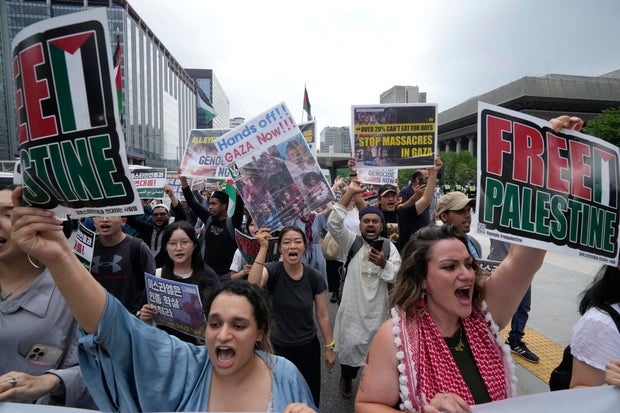CBS News
Transgender Afghans escape Taliban persecution only to find “a worse situation” as refugees in Pakistan

Islamabad — Issues of gender and sexuality have long been taboo in ultra-conservative Afghanistan, and more so since the Taliban retook control of the country in 2021. For some members of the LGBTQ community, the Taliban’s comeback seemed too much of a risk, so they fled to neighboring Pakistan with countless other Afghan refugees.
In late 2023, Pakistan started a controversial program to expel Afghan refugees who lack documentation, fueling fears in particular for LGBTQ refugees like Laila Khan and Jannat, young transgender women who met with CBS News at a guesthouse where they’ve been living in Pakistan’s capital Islamabad.
Human rights groups say hundreds, if not thousands, of Afghan transgender refugees have sought safety in Pakistan, and about 50 have already approached courts in Peshawar seeking protection.
Laila and Jannat tell CBS News that life under the Taliban was unbearable, but circumstances in Pakistan haven’t been much better.
The Taliban’s “truly depressing” takeover
Jannat, who didn’t want to use her full name, said growing up in Afghanistan in the wake of the U.S.-led invasion, with a Western-backed government in power, she “was luckily able to complete my education until grade 12, despite being unwanted and unwelcome in Afghan society.”
CBS News
Since the Taliban returned to power, however, Afghanistan’s transgender community has faced even harsher mistreatment. The Taliban regime does not recognize the existence of transgender people as a group, so there is no way for them to seek justice when they face gender-based abuse or discrimination.
“We were relatively safe in Afghanistan before the Taliban came, but after their victory and takeover, we could not even walk outside,” Khan told CBS News. “It is truly depressing.”
She told CBS News about a time she says she was chased home by Taliban security forces.
“They reached my home and told my parents to ‘keep that piece of shame at home,” she said. They also warned her parents to prevent her from “corrupting others.”
“This is not my fault,” she said. “I didn’t choose this as God made me this way.”
“We are in a worse situation”
Jannat and Laila decided they were no longer safe in their country — though Jannat said she’d had serious concerns about seeking safety in Pakistan.
“I used to read about the violence against transgenders in Pakistan,” she said. “It made me scared, but I had no choice.”
They both crossed into Pakistan with help from a European organization dedicated to helping members of the Afghan transgender community. But they told CBS News that transgender Afghans face many of the same security concerns in Pakistan that they had in their own country.
“Being an Afghan refugee is not easy in Pakistan, it’s even harder to be a transgender refugee in a country that is not so welcoming to the LGBTQ community,” Khan said.
Khan said she’s faced discrimination since arriving in Pakistan, including by a landlord who refused to rent her a home when he saw that she was transgender.
“I had the money. I was able to afford it. The landlord had the paperwork ready, but once he saw us, his attitude changed and he declined the tenancy agreement,” she said.
Khan said she faced regular harassment and discrimination in Islamabad, including fellow passengers on a packed bus refusing to come near her, a taxi driver who verbally harassed her, and even police officers whom she said “tried to touch my private parts after I was stopped at a checkpoint, to find my sexual status, which was humiliating.”
“In Pakistan we are in a worse situation,” said Jannat, “because the hatred toward refugees is prominent here, but then when the authorities discover that we are transgender, they act even worse with us… I can’t even go to the doctor or to the shops.”
Rights granted, but not guaranteed?
“Pakistani citizens who are transgender or members of the third gender are a recognized minority group and are thus entitled to certain civil rights, but it is not always the case” for refugees, Khan told CBS News. Third gender refers to individuals who do not identify as either male or female.
Hayat Roghani, lawyer who has represented transgender Afghan refugees in cases at the high court in the northern Pakistani city of Peshawar, told CBS News that transgender people are a recognized minority group under Pakistani law, which entitles them to certain civil rights including, for Pakistani nationals, property ownership and voting.
“Afghanistan has absolutely nothing for transgenders,” he said, adding that his advocacy organization is currently handling the cases of about 50 transgender Afghan refugees. He said some of them don’t have documentation permitting them to remain in Pakistan, so if they’re caught, he fears they’ll be deported back to Afghanistan.
“The lack of rights and safety for transgenders under Taliban rule is deeply concerning,” Farzana Riaz, president of the Peshawar-based rights group Trans Action Pakistan, told CBS News. “But unfortunately, even for the transgender Afghans who managed to cross into Pakistan, it does not mean an end to their problems, only a new chapter of problems.”
“I don’t think any of the transgender Afghans have been deported,” Peshawar police spokesperson Alam Khan said when asked about the accounts provided to CBS News. “As a law enforcement agency, we are fully committed to following up on all complaints made by anyone — regardless of whether they are Afghans or locals.”
Khan said the Peshawar police had held “a series of meetings with the transgender community to solve the community’s problems, based on its priorities,” adding that the department was using “all resources for the protection of the rights of transgenders.”
CBS News
Street medics treat heat illnesses among homeless people as temperatures rise

Alfred Handley leaned back in his wheelchair alongside a major Phoenix freeway as a street medicine team helped him get rehydrated with an intravenous saline solution dripping from a bag hanging on a pole.
Cars whooshed by under the blazing 96-degree morning sun as the 59-year-old homeless man with a nearly toothless smile got the help he needed through a new program run by the nonprofit Circle the City.
“It’s a lot better than going to the hospital,” Handley said of the team that provides health care to homeless people. He’s been treated poorly at traditional clinics and hospitals, he said, more than six years after being struck by a car while he sat on a wall, leaving him in a wheelchair.
Circle the City, a non-profit that works in multiple cities and hospitals and treats about 9,000 people annually, introduced its IV rehydration program as a way to protect homeless people in Phoenix from life-threatening heat illness as temperatures regularly hit the triple-digits in America’s hottest metro.
Matt York / AP
Homeless people accounted for nearly half of the record 645 heat-related deaths last year in Maricopa County, which encompasses metro Phoenix. As summers grow warmer, health providers from San Diego to New York are being challenged to better protect homeless patients.
Dr. Liz Frye, vice chair of the Street Medicine Institute which provides training to hundreds of healthcare teams worldwide, said she didn’t know of groups other than Circle the City administering IVs on the street. The organization also distributes tens of thousands of water bottles each summer and tries to educate people about hot weather dangers.
“But if that’s what needs to happen to keep somebody from dying, I’m all about it,” Frye said.
Bringing care to people in need
The amount of people requiring treatment for heat illnesses is rising. The Boston Health Care for the Homeless Program, featured in last year’s book, “Rough Sleepers,” now sees patients with mild heat exhaustion in the summer after decades of treating people with frostbite and hypothermia during the winter, said Dr. Dave Munson, the street team’s medical director.
“It’s certainly something to worry about,” said Munson, noting that temperatures in Boston hit 100 degrees with 70% humidity during June’s heat wave. Homeless people, he said, are vulnerable to very hot and very cold weather not only because they live outside, but they often can’t regulate body temperature due to medication for mental illness or high blood pressure, or because of street substance use.
The Phoenix team searches for patients in homeless encampments in dry riverbeds, sweltering alleys and along the canals that bring water to the Phoenix area. About 15% are dehydrated enough for a saline drip.
Matt York / AP
“We go out every day and find them,” said nurse practitioner Perla Puebla. “We do their wound care, medication refills for diabetes, antibiotics, high blood pressure.”
Puebla’s street team ran across Handley and 36-year-old Phoenix native Phillip Enriquez near an overpass in an area frequented by homeless people because it’s near a facility offering free meals. Across the road was an encampment of tents and lean-tos along a chain-link fence.
Enriquez sat on a patch of dirt as Puebla started a drip for him. She also gave him a prescription for antibiotics and a referral to a dentist for his dental infection.
Living outside in Arizona’s broiling sun is hard, especially for people who may be mentally ill or use sedating drugs like fentanyl that make them less aware of their surroundings. Stimulants like methamphetamine contribute to dehydration, which can be fatal. Dr. Matt Essary, who works with Circle in the City’s mobile clinics, said the organization also often treats surface burns that can happen when a medical emergency or intoxication causes someone to fall on a sizzling sidewalk.
Matt York / AP
Temperatures this year have reached 115 degrees in metro Phoenix, where six heat-related deaths have been confirmed through June 22. Another 111 are under investigation, and the city is seeing an “increasing” number of patients with heat illnesses every year, according to Dr. Aneesh Narang, the assistant medical director of emergency medicine at Banner Medical Center-Phoenix, which treats many homeless people with heat stroke.
Narang’s staff works frequently with Circle the City, whose core mission is providing respite care, with 100 beds for homeless people not well enough to return to the streets after a hospital stay.
Extreme heat worldwide requires a dramatic response, said physician assistant Lindsay Fox, who cares for homeless people in Albuquerque, New Mexico, through an initiative run by the University of New Mexico’s School of Medicine.
Three times weekly, Fox treats infections, cleans wounds and manages chronic conditions in consultation with hospital colleagues. She said the prospect of more heat illness worries her.
Highs in Albuquerque can hit the 90s and don’t fall enough for people living outside to cool off overnight, she said.
“If you’re in an urban area that’s primarily concrete, you’re retaining heat,” she said. “We’re seeing heat exposure that very quickly could go to heat stroke.”
Serious heat stroke is far more common in metro Phoenix, where Circle the City is now among scores of health programs for the homeless in cities like New York, San Diego and Spokane, Washington.
Circle the City works with medical staff in seven Phoenix hospitals to help homeless patients get after-care when they no longer need hospitalization. It also staffs two outpatient clinics for follow-up.
Rachel Belgrade waited outside Circle the City’s retrofitted truck with her black-and-white puppy, Bo, for Essary to write a prescription for the blood pressure medicine she lost when a man stole her bicycle. She accepted two bottles of water to cool off as the morning heat rose.
“They make all of this easier,” said Belgrade, a Native American from the Gila River tribe. “They don’t give you a hard time.”
CBS News
Hamas appears to clear way for possible cease-fire deal with Israel after reportedly dropping key demand

There is new hope for a cease-fire deal in the Middle East after Hamas responded to a U.S.-backed proposal for a phased deal in Gaza.
The militant group – which controlled Gaza before triggering the war with an Oct. 7 attack on Israel – has reportedly given initial approval of the cease-fire deal after dropping a key demand that Israel give an up-front commitment for a complete end to the war, a Hamas and an Egyptian official told the Associated Press on Saturday.
A senior U.S. official says that Hamas’ response to the proposal “may provide the basis for closing the deal.”
The apparent compromise could deliver the first pause in fighting since November and set the stage for further talks on ending the devastating nine months of fighting. But all sides cautioned that a deal is still not guaranteed.
The two officials, who spoke on condition of anonymity to discuss ongoing negotiations, told the Associated Press that Washington’s phased deal would first include a “full and complete” six-week cease-fire that would see the release of a number of hostages, including women, older people and the wounded, in exchange for the release of hundreds of Palestinian prisoners. During the 42 days, Israeli forces would withdraw from densely populated areas of Gaza and allow the return of displaced people to their homes in northern Gaza, the officials said.
Over that period, Hamas, Israel and mediators would negotiate the terms of the second phase that could see the release of the remaining male hostages, both civilians and soldiers, the officials said. In return, Israel would free additional Palestinian prisoners and detainees. The third phase would see the return of any remaining hostages, including bodies of dead captives, and the start of a years-long reconstruction project.
Ahn Young-joon / AP
Hamas still wants “written guarantees” from mediators that Israel will continue to negotiate a permanent cease-fire deal once the first phase goes into effect, the officials said.
The Hamas representative told The Associated Press the group’s approval came after it received “verbal commitments and guarantees” from the mediators that the war won’t be resumed and that negotiations will continue until a permanent cease-fire is reached.
“Now we want these guarantees on paper,” he said.
In line with previous proposals, the deal would see around 600 trucks of humanitarian aid entering Gaza daily — including 50 fuel trucks — with half of them bound for the hard-hit northern of the enclave, the two officials said. Following Israel’s assault on the southernmost city of Rafah, aid supplies entering Gaza have been reduced to a trickle.
Israel launched the war in Gaza after Hamas’ October attack in which militants stormed into southern Israel, killed some 1,200 people — mostly civilians — and abducted about 250. Israel says Hamas is still holding about 120 hostages — about a third of them now thought to be dead.
Since then, the Israeli air and ground offensive has killed more than 38,000 people in Gaza, according to the Hamas-run Health Ministry, which does not distinguish between combatants and civilians in its count. The offensive has caused widespread devastation and a humanitarian crisis that has left hundreds of thousands of people on the brink of famine, according to international officials.
Months of on-again off-again cease-fire talks have stumbled over Hamas’ demand that any deal include a complete end to the war. Prime Minister Benjamin Netanyahu has offered to pause the fighting but not end it until Israel reaches its goals of destroying Hamas’ military and governing capabilities and returning all hostages held by the militant group.
Netanyahu’s office did not respond to requests for comment, and there was no immediate comment from Washington.
CBS News previously reported that an Israel delegation headed by Mossad Director David Barnea was traveling to Qatar for talks. Sources told CBS News that Barnea was set to meet with Qatari Prime Minister Sheikh Mohammed bin Abdulrahman Al Thani for discussions.
On Friday, the Israeli prime minister confirmed that the spy agency’s chief had paid a lightning visit to Qatar, a key mediator. But his office said “gaps between the parties” remained.
President Biden held a 30-minute call with Netanyahu on Thursday, a senior Biden administration official told reporters, during which the two leaders walked through the latest draft of the proposal.
U.S. officials have said the latest proposal has new language that was proposed to Egypt and Qatar on Saturday and addresses indirect negotiations that are set to commence during the first phase of the three-phase deal that Mr. Biden laid out in a May 31 speech.
Hamas has expressed concern Israel will restart the war after the hostages are released. Israeli officials have said they are worried Hamas will draw out the talks and the initial cease-fire indefinitely, without releasing all the hostages.
Netanyahu is under pressure from Israel’s closest ally – the United States – to negotiate a ceasefire, but at home, two far-right wing members of his cabinet have threatened to bring down the governing coalition if he agrees to a truce.
Israel bombardment continues
The Hamas-run Interior Ministry said four police officers were killed in an Israeli airstrike Saturday in Rafah, the AP reported. The ministry, which oversees civilian police, said the officers were killed during foot patrol securing properties. It said eight other police officers were wounded. Israel’s military did not immediately respond to questions.
In Deir al-Balah, prayers were held for 12 Palestinians, including five children and two women, killed in three separate strikes in central Gaza on Friday and Saturday, according to hospital officials. The bodies were taken to al-Aqsa Martyrs Hospital, where AP journalists counted them.
Two of those killed in a strike that hit the Mughazi refugee camp Friday were employees with the United Nations agency for Palestinian refugees, the organization’s director of communications told the AP. Juliette Touma said a total of 194 workers with the agency have been killed since October.
Jehad Alshrafi / AP
Earlier this week, an Israeli evacuation order in the southern city of Khan Younis and the surrounding areas affected about 250,000 Palestinians. Many headed to an Israeli-declared “safe zone” centered on the Muwasi coastal area or Deir al-Balah.
Ground fighting has raged in Gaza City’s Shijaiyah neighborhood for the past two weeks, forcing tens of thousands of people to flee their homes. Many have sheltered in the Yarmouk Sports Stadium, one of the strip’s largest soccer arenas.
CBS News
Watch owned by Theodore Roosevelt recovered decades after theft

Watch CBS News
Be the first to know
Get browser notifications for breaking news, live events, and exclusive reporting.













